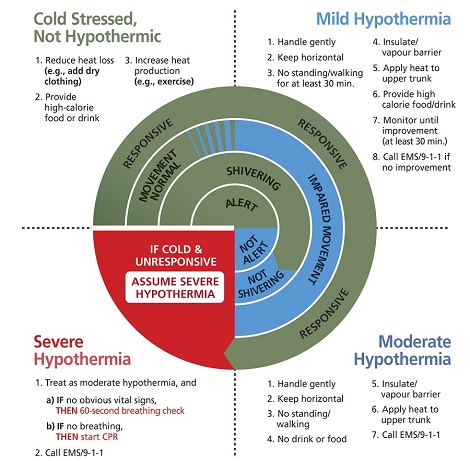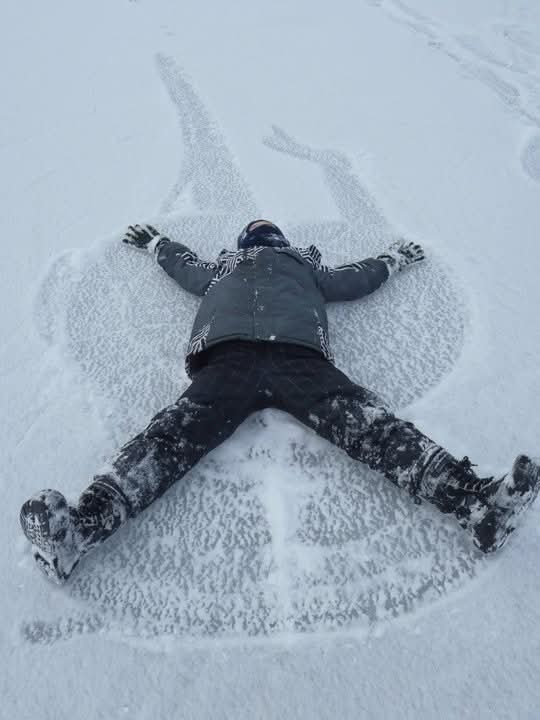**** Via Red Cross
Cold-Related Emergencies: Staying Warm and Safe in Canadian Winters
Winter does not just bring snow and cold temperatures, it also brings enjoyable winter activities such as skiing, ice skating, snowmobiling, sledding, ice fishing, snowshoeing and fat biking. While these activities create lasting winter memories, they also have the potential to cause injury.
It is important for everyone enjoying the outdoors to know how to recognize when someone has been exposed to cold for too long, prevent cold-related emergencies, and be able to provide help when needed.
Prevention
- Cover your head and trunk by wearing a hat and layers of tightly woven fabrics such as wool or synthetics.
- Cover up exposed areas such as your fingers, cheeks, ears, and nose.
- If your clothes get wet when you are in the cold, change into dry clothes as soon as possible.
- Drink plenty of warm fluids to help your body stay warm and hydrated, avoid caffeine and alcohol.
- Eat high calorie food and drinks regularly as the body converts food to energy which heats the body.
- Dress in layers so that you can adjust to changes as you heat up or cool off.
- Bring additional warm clothing when going out for extended periods or in case of emergency.
- Don’t wear tight fitting clothing or footwear that may impair circulation.
- Seek shelter from the wind if you are getting cold, even if it is only behind a tree, hill, embankment, or other landscape feature.
Recognizing when someone is suffering from a cold-related emergency
Frostbite
Frostbite is a serious condition in which body tissues freeze. It happens most often in the fingers, toes, ears, and nose.
There are two levels of frostbite: Superficial frostbite occurs when the skin freezes but the underlying tissues are unaffected. It may produce clear blisters after the tissue thaws, but little or no tissue loss typically occurs. Deep frostbite occurs when tissues beneath the skin (including tendons, muscles, and blood vessels) freeze. Inside the body, ice crystals and swelling begin to damage or destroy the body’s cells, blood vessels, and nerves. Deep frostbite may produce dark, hemorrhagic blisters when the tissue thaws, and is more likely to result in tissue loss.
Before frostbite occurs, a person’s skin may appear shiny and rosy (a condition sometimes called “frost nip”). This is a warning that frostbite is imminent. If you see these signs, move to a warmer environment or protect the skin with layers of clothing.
Signs and symptoms of superficial frostbite include:
- Hardened skin
- Skin that looks paler than the area around it
- Pain or stinging in the area, followed by numbness
Signs and symptoms of deep frostbite include:
- Waxy skin that is colder than the area around it
- Skin and underlying tissue that is hard and solid to the touch
- Skin that is white, blue, black, or mottled
- Complete loss of feeling
Hypothermia
When a person is exposed to cold temperatures it may result in a decrease in body temperature, which is called a cold-related emergency. Hypothermia can happen to anyone who is exposed to cold temperatures for too long, and it can be life threatening.
Mild hypothermia – Shivering and complaining of cold, numbness in fingers and toes, body temperature slightly below normal.
Moderate hypothermia – Shivering, numbness in fingers and toes, lack of coordination and/or speech, confused or unusual behaviour, impaired judgment.
Severe – Person has stopped shivering and complaining of cold, lack of coordination and/or speech, confused or unusual behaviour, impaired judgment, glassy stare, body temperature below 30°C, breathing has slowed down or stopped, possible unconsciousness.
How to help
- Call EMS/9-1-1 for severe hypothermia.
- Treat the person gently and monitor breathing carefully.
- Get the person away from the cold and into shelter.
- Remove any wet clothing and gently pat dry the person.
- Warm the person by wrapping him or her in blankets or putting on dry clothing. Cover the head and neck. Warm the person slowly.
- If hot water bottles or heating pads are available put them under armpits and on the chest only, being careful not to burn these areas.
- Do not rub areas that appear to be affected by frostbite.
- If the person is alert, give him or her sips of warm liquids to drink.
- Active re-warming such as hot baths should be used only when the person is far from a medical facility.
- Keep the affected areas warms to prevent re-freezing.

Outdoor temperatures and wind chill readings
Wind chill is a term used by weather forecasters to tell us how much colder the wind makes unprotected skin feel. Wind doesn’t change the temperature outside, but it affects our skin temperature. A person will feel it’s colder because the wind steals body heat by blowing away the warm air that surrounds the skin. It is especially important for individuals participating in high-speed activities such as skiing, tobogganing, running, and cycling to be aware of wind speed and wind chill index and to cover exposed skin— they may feel warm and be sweating but could unknowingly freeze exposed skin such as cheeks and nose. For details on wind chill hazards, wind chill index and risks, see Environment Canada’s Wind Chill Index.
–




